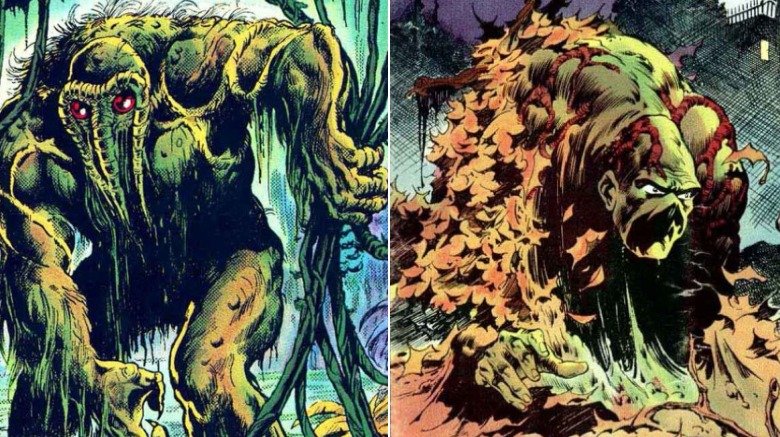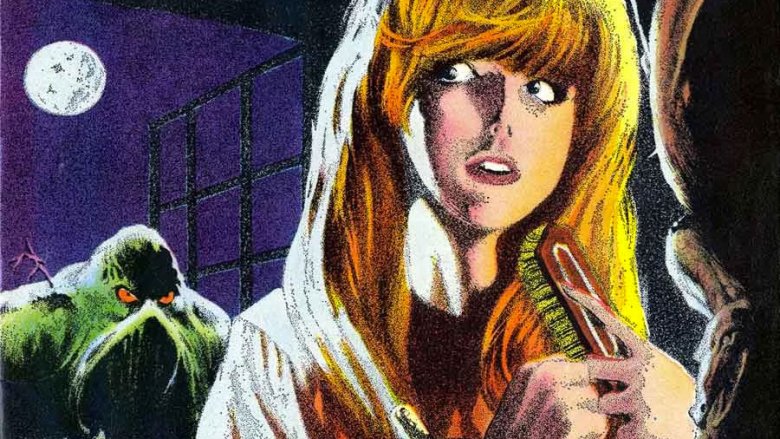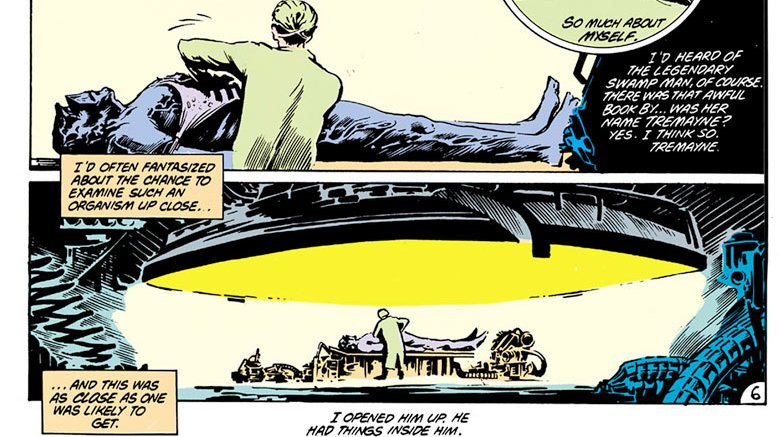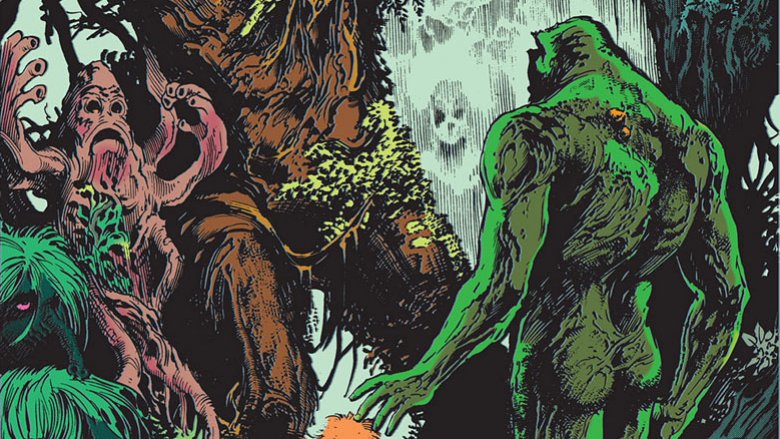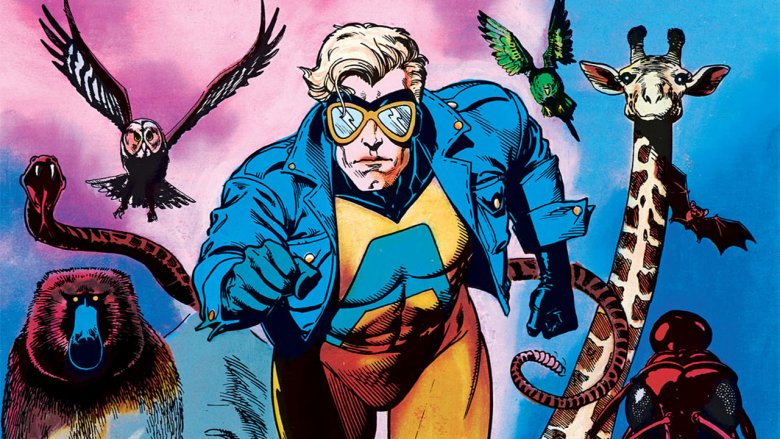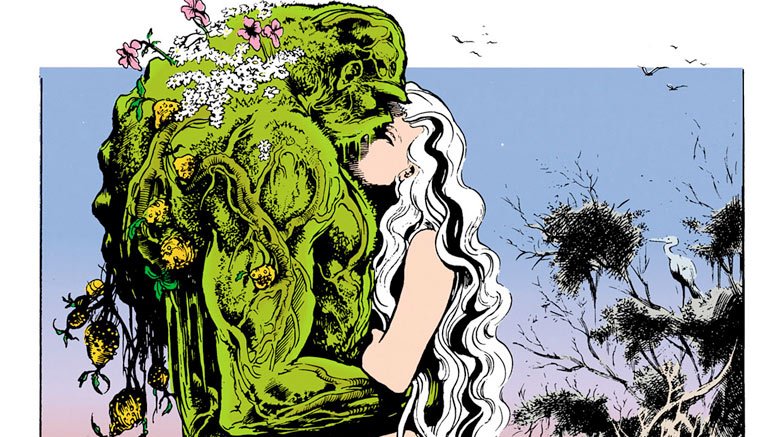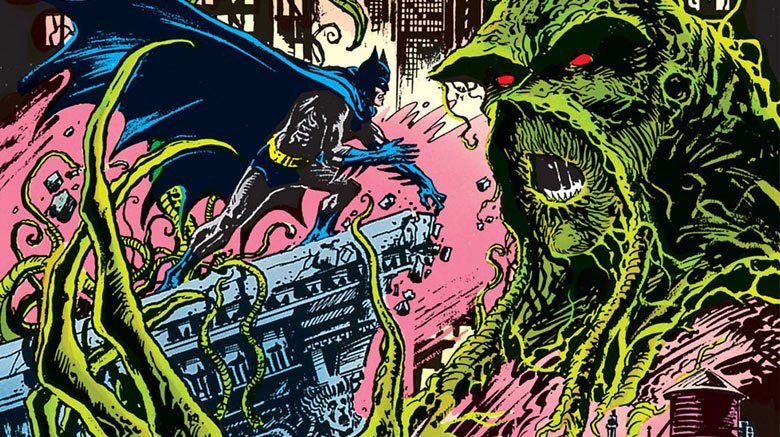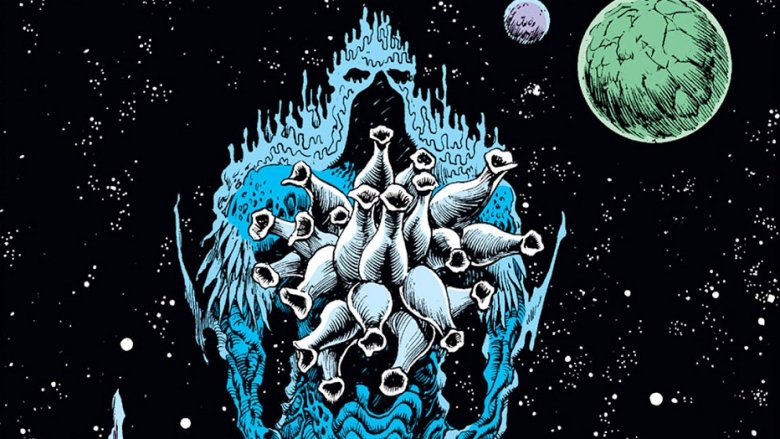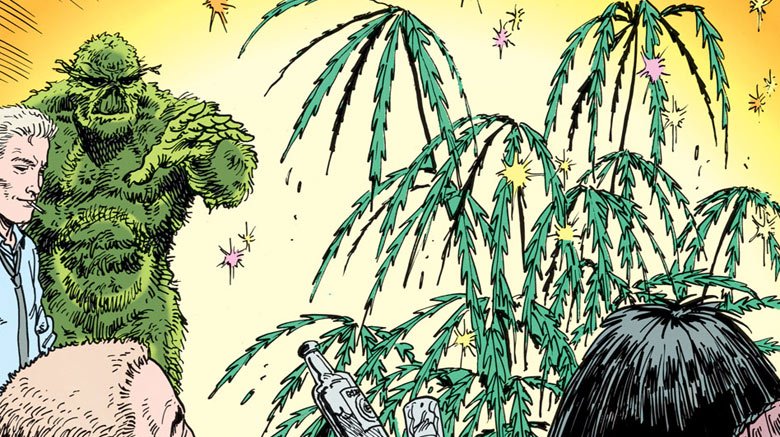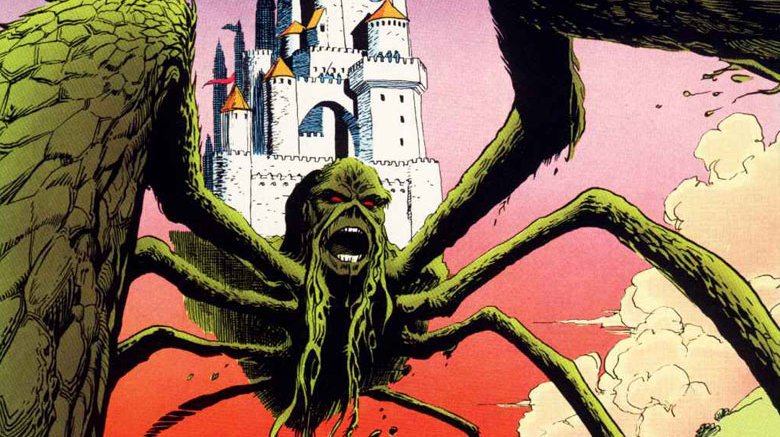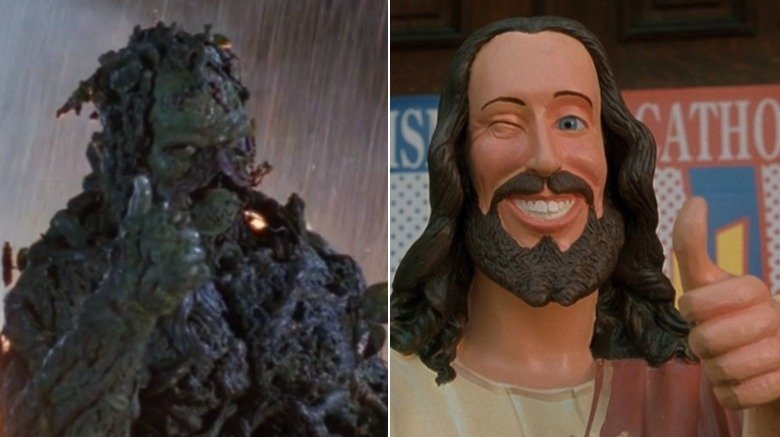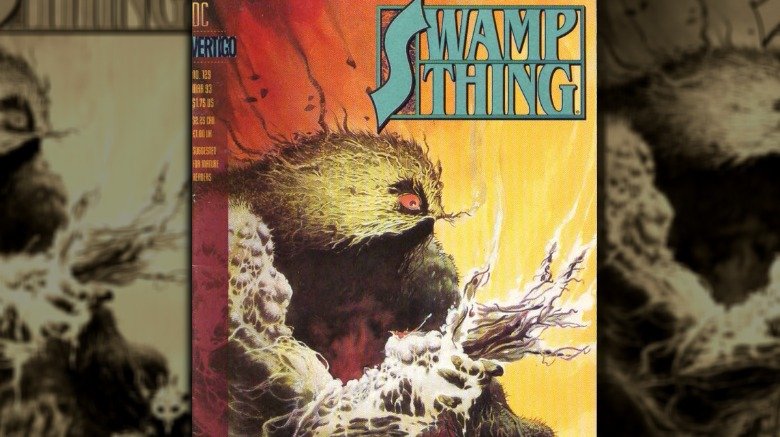The Untold Truth Of Swamp Thing
Swamp Thing! He is amazing! And since his debut in 1974, he's been one of the most fascinating characters in the entire DC Comics lineup. The character combines elements of monster comics and suspense stories with the epic qualities of superheroes in a way that no other comic book character can match.
But through the years, Alec Holland (or the creature that has his memories) has become a lot more complicated than a simple talking tree who occasionally fights villains. From his origins as a straightforward man-turned-monster, to his rebirth as an Avatar of the Green, and all the way to his current status as one of the most iconic horror characters in comics, Swamp Thing's history has as many twists and turns as the twigs of a corkscrew willow tree. If you're ready to branch out and learn more, then join us as we leaf through the truth about Swamp Thing, from his earliest roots right to today!
Convergent evolution
While he would definitely go on to become the most famous of them all, Swamp Thing is by no means the first swamp monster in comics. In fact, he's not even the first one created in the early '70s at one of the major superhero publishers. That honor in particular goes to Marvel's Man-Thing, created by Roy Thomas, Gerry Conway, and Gray Morrow in the pages of 1971 Savage Tales #1. In that story, Dr. Ted Sallis is working in the swamp on a formula meant to give people super-powers when he's attacked by criminals and gets exposed to it himself, plunging into the swamp and emerging as the vegetation-based monster known as... Man-Thing!
Months later, Len Wein and Berni Wrightson introduced their new swamp monster in the pages of House of Secrets #92. In that story, Dr. Alex Olsen is working in the swamp on a formula meant to give people super-powers when he's attacked by criminals and gets exposed to it himself, plunging into the swamp and emerging as the vegetation-based monster known as... Swamp Thing!
Swamp Man or Thing Thing?
Needless to say, Gerry Conway noticed the similarities between Man Thing and Swamp Thing, which were especially apparent given that Len Wein had a) written the second, then-unpubilshed Man Thing story, and b) Conway and Wein were actually roommates in New York at the time. According to an interview with Roy Thomas in Alter Ego, there was some talk of legal action from Marvel, but they needn't have worried. Despite the similar origins, the two characters would take wildly divergent paths once Wein and Wrightson rebooted Swamp Thing as a more heroic leading character who bore the name Alec Holland. While Man-Thing would get into some truly weird adventures as the guardian of the Marvel Universe's Nexus of All Realities, Swamp Thing would always exist only on the fringes of his superheroic world, and get into some much darker stories.
Besides, if we're being honest, both characters bore a pretty striking resemblance to the Heap, a short-lived Golden Age swamp monster who would be briefly revived after Man-Thing and Swamp Thing's shared successes.
The Anatomy Lesson
Swamp Thing's origin is about as straightforward as superhero comics can get without involving a radioactive spider: Alec Holland gets doused with a special "bio-restorative" formula when he's attacked by crooks, falls into a swamp, and instead of dying, he emerges from the mire as a vegetable-human hybrid. Simple, right? Except that in 1983, it turned out that wasn't his origin after all.
When legendary writer Alan Moore joined artists Stephen Bissette and John Totleben, the first thing he did was tie up loose ends from the previous 19 issues in a story called, appropriately enough, "Loose Ends." The second thing he did was completely change how Swamp Thing worked in a story called "The Anatomy Lesson." Structured around a literal autopsy of Swamp Thing's body performed by Jason Woodrue — a relatively obscure plant-based villain known as the Floronic Man — Swamp Thing #21 revealed that he wasn't really Alec Holland at all. Instead of a transformation, the bio-restorative formula had caused the swamp to somehow imprint on Holland, recreating his mind in a new form that was completely different from his original body.
Moore's later stories would confirm this in the most irrevocable way possible, showing readers that the real Alec Holland's soul had made it to the afterlife after his murder in Louisiana. That in turn raised the question that would be explored throughout the rest of this groundbreaking run: if Swamp Thing wasn't Alec Holland...just what was he?
The Green
In 1986, Alan Moore, Stan Woch, and Ron Randall re-established Swamp Thing as something more than just a swamp monster. Instead, he was the latest in a long line of plant elementals who were connected to what they called the Green — a mystical field encompassing all of Earth's plant life. In Swamp Thing #47, the title character discovered the Parliament of Trees, a council of elders who had themselves been the elementals in their times, all of whom shared the origin of dying in fire and then being reborn as plants.
This allowed Moore to connect Swamp Thing to other plant monsters through that similarity. DC characters like Solomon Grundy, the original swamp zombie who battled against the Golden Age Green Lantern, the Floronic Man, and even Poison Ivy were added to that connection, but it went beyond just their pages. The only other elemental that we get an explicit backstory for in that issue shares a suspiciously similar origin with the Heap, right down to the year, and the reference to how "the origin is always the same" is pretty easy to read as an acknowledgement of Man-Thing, too.
This also let them explain the differences between Alec Holland's origin story in Swamp Thing #1 and the prototype Alex Olsen version back in House of Secrets. It also made Swamp Thing functionally immortal. As long as that connection to the Green persisted, he could simply grow a new body if his was destroyed, and could teleport across the planet by casting out his consciousness and growing a new one from a plant somewhere else.
The Red, the Clear, and the Rot
Connecting Swamp Thing to the Green provided a simple explanation of his powers and a unifying connection to other characters, and it's remained a part of the character ever since. It worked so well, that the same idea extended to other characters, creating an entire rainbow of DC heroes.
Animal Man had a head start. The idea behind this forgotten hero had always been that he could access the abilities of animals by tapping into a "morphogenetic field" that contained a sort of platonic ideal of everything an animal could do. That explained how he could fly like a bird without wings, and how he could use a lizard's ability to re-grow a severed tail if he lost an arm in battle. From there, it was an easy jump in 2011 to reclassify the morphogenetic field as "The Red," connecting Animal Man to characters like Vixen and Beast Boy.
It didn't stop there. The White, an air-based force, had been introduced in the '90s. Eventually, Aquaman's ability to talk to fish was explained as the Atlantean ability to tap into the somewhat hilariously named Clear. It wasn't all good-guy stuff, though. The same story that tied Animal Man to the Red also introduced the death force known as the Rot. As you might expect, that caused its share of problems for the heroes, and would eventually cause Swamp Thing's eventual ladyfriend, Abby Arcane, to inherit her uncle's title as the Avatar of Death.
Love in the time of dendrophilia
While he still retained Alec Holland's memories and the remnants of his personality, Swamp Thing's complete separation from his former human identity allowed for some interesting storytelling — mainly in that it allowed him to finally get a love interest.
See, in the beginning, "Alec Holland" was mourning both his own status as an undead muck monster and the death of his wife, Linda, who perished in his own fiery origin. Meanwhile, the human perspective on his adventures fell to Abigail Arcane — niece of the depraved supervillain Anton Arcane — and her boyfriend Matt Cable. Unfortunately for her, Matt was killed, and in one of the most horrifying moments of a comic that put the scares back in superheroes, it was revealed that Anton had been possessing Matt's body without Abbey knowing.
So Matt was dead, "Alec" turned out to have never actually been married, and Anton was killed and cast down into literal Hell. The way was clear for Swamp Thing and Abbey to fall in love with each other, sparking one of DC's most enduring romances — which is kind of surprising considering that one of the lovers in question was a shambling monster made of trees. Still, it worked, even if the other residents of Houma, Louisiana were freaked out by Abby's dendrophilia — which, incidentally, is the word for when you have a plant fetish. Who says you can't learn anything from comics?
He beat Batman
You might find this hard to believe, but it turns out that in some states, it's actually illegal to make love with a swamp monster — or at least, it was in the DC Universe in 1986. We can assume this is a slightly more pressing concern there than it is in our world, but you'd probably have to check the Lee County Lizard Man's Tinder profile to be sure. Either way, once Abby Arcane's swamp-based romance was discovered, she was arrested and taken to jail. Naturally, Swamp Thing wasn't happy about this, and launched an all-out assault on the city to get her back. There's just one problem: the city where she was being held was a little place called Gotham.
Needless to say, Batman didn't appreciate having his hometown turned into a jungle. While he did his level best to fight the Swamp Thing off, he found out that an Avatar of the Green isn't as easy to take down as, say, the Riddler. Instead, Swampy just kept coming back bigger and tougher, growing kaiju-sized, until Batman saw his point and convinced the arresting officer to let Abby go. After all, Batman reasoned, if you're going to arrest non-human heroes for having romantic relationships with human women, you're eventually going to have to try slapping handcuffs on Lois Lane and Superman, and that's not going to work out well for anyone.
Lex Luthor basically sent him to another planet
While Swamp Thing managed to beat Batman on his home turf, there was one other DC character involved in the aforementioned story. When Swamp Thing's enemies found themselves at a loss for how to truly kill their leafy nemesis, they contacted someone with plenty of experience dealing with invulnerable enemies: Lex Luthor. In 9 minutes and 15 seconds, Luthor concocted a plan that would get rid of Swamp Thing once and for all by severing his connection to the Green, trapping him in his body, and then destroying it. It worked, too; the only way Swampy survived was by casting his consciousness into the depths of space and reforming on another planet.
With enemies like that, you might wonder if Swamp Thing has any friends. It turns out, he does: in Batman #522, it was revealed that their shared swampy origins had allowed him and Killer Croc to become buds. Get it? Buds?
Reefer madness
For a certain kind of reader, there's only one question that comes to mind when they find out that Swamp Thing and Abby Holland (née Arcane) are married: how do they... you know... do it? Easy: with his absolute control over plants and their properties, Swamp Thing has the ability to grow sweet potato-like psychotropic tubers that allow Abby to commune with her husband within the Green, with typically orgasmic results.
Simple.
That's not Swamp Thing's only experience with mind-altering substances, though. In Hellblazer #63, he got an invite to John Constantine's 40th birthday party. It makes sense that he would, since Constantine had originally appeared as a supporting character in Swamp Thing #25, but since the characters had never exactly been chummy, it came as quite a surprise. Still, never let it be said that John Constantine is one to pass up an opportunity. As a birthday present, he got Swamp Thing to rapidly grow a single marijuana leaf into enough weed for everyone. "Communing with the Green" indeed.
Swamp to the Future
It's never to follow up a legendary creator's definitive work, but when Alan Moore left Swamp Thing in 1987, his longtime collaborator Rick Veitch proved he was up to the task. A year into his own run, he even launched one of the most memorable stories on the book ever: a time-travel epic that saw Swamp Thing uncontrollably hurled back through the ages, encountering heroes and villains from throughout DC Comics history. He teamed up with Sgt. Rock in World War II, battled the Enemy Ace in World War I, dealt with Jonah Hex in the Old West, and even defended King Arthur during the fall of Camelot.
And then Veitch abruptly left the book in mid-story, leaving Doug Wheeler to take over and finish it with Swamp Thing #88. If you were reading at the time, the reason for Veitch's departure was no secret, and was even the topic of discussion in the book's letters page for several months: DC asked Veitch at the last minute to change the end of his storyline, he refused, and that was that. But what changes could've been so huge that caused Veitch to abandon the book just before the end?
The greatest story never told
Rick Veitch's original plan had been to keep Swamp Thing traveling backwards through time, with his next stop landing him in the Roman Empire circa 33 AD, where he'd have a team-up with the obscure Golden Gladiator. Oh, and he was also going to possess the wood upon which Jesus Christ was crucified.
Only a few years later, it's unlikely that this story would've been a problem. By 1995, DC's Vertigo imprint was publishing Preacher, a book that reveled in over-the-top blasphemy that made "Swamp Thing meets Jesus" look like a Sunday School lesson. At the time, though, Vertigo had yet to be formally established. While it bore a "Mature Readers" tag, Swamp Thing was still firmly set in the DC Universe. DC's higher-ups balked at having that story happen in the same world as Superman. In protest, Veitch left the book — and, for a time, DC — and his version of Swamp Thing #88 remains unpublished.
The rise of Vertigo
To say that Swamp Thing under Moore was a success is putting it mildly. It cemented Moore as a star, which led directly to the groundbreaking Watchmen, and also marked the revitalization of mainstream supernatural horror comics. Swamp Thing itself continued for over 100 issues after Moore left, featuring work by creators like Grant Morrison, Mark Millar, and Phil Hester. More than that, though, it paved the way for DC to try out other, weirder titles using the same formula.
Animal Man and Doom Patrol, both written by Grant Morrison, marked the first weirdo follow-ups, but the big one is Sandman. Readers who consumed Neil Gaiman and Sam Keith's version in droves may not have realized it, but like Swamp Thing and the other titles, it was a reboot of an existing DC hero — the Golden Age hero Wesley Dodds, who fought crime through his prophetic dreams. By 1993, the horror titles were so successful that DC created an entire horror-themed imprint around them called Vertigo, which eventually branched out to encompass DC's entire "Mature Readers" line, launching hits like Preacher, Y – The Last Man, iZombie, and Fables.
Moore, however, was typically sour about the whole enterprise, perhaps due to his longstanding grudge against DC over their exploitation of Watchmen. In an interview with Jonathan Ross (among others), he said that Vertigo's entire deal was "the result of a bad mood I was in" back in the '80s.
Swamp Thing conquers the screen... sort of
Thanks to some of the best comics of the decade, Swamp Thing was getting critical acclaim and a devoted fan-base... in comics. In other media, however, the quality didn't exactly translate. That didn't keep DC and Warner Bros. from trying, though.
The first attempt came in 1982 from Wes Craven, the legendary horror director who went on to direct A Nightmare on Elm Street and Scream, among others. It stuck to Wein and Wrightson's origin story, pitting Alec Holland against Anton Arcane, with Matt Cable swapped out for Alice Cable, as played by Adrienne Barbeau. It wasn't exactly a success, but it garnered generally positive reviews, with Roger Ebert giving it three stars out of four. Its sequel, 1988's Return of Swamp Thing, however, wasn't so lucky. With a low budget and a script that failed to bring the thrills the comic's audience wanted or the fun that kids who liked monsters demanded, it flopped hard.
It did, however, pave the way for not one, but two television shows. In 1990, Dick Durock returned to the role he'd played in both movies for a series that shockingly ran for three seasons on USA. In 1991, things got even weirder when Fox Kids got in on the action and launched a Swamp Thing animated series. Sadly, that one only lasted five episodes before it got axed, but it did give the world its theme song. Nothing in Swamp Thing's incredibly strange history has ever been as bizarre as hearing someone sing about Anton Arcane to the tune of "Wild Thing."
